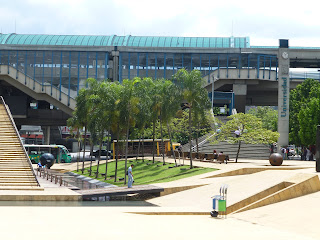Current location: click here
Located in the northern part of the Andes, Medellin was outside the main colonial gold, silver and pirate routes. This was perhaps the reason why it did not get the same attention from the Spanish conquistadores as let's say Cartagena, and it wasn't until the Medellin Cartel illegal activities in the 70's and 80's that the city got worldwide attention, in a negative sense.
In 1988, random bombings and street shootings were regular occurrences, organized by drug lords in the cocaine trade who wanted to display their power and create terror amongst the government and rivals in the Cali Cartel. The city was considered the cocaine capital of the world, as it controlled about 80% of the cocaine that entered the US. Pablo Escobar, the drug mastermind behind it all, was eventually killed in 1993, a turning point in Medellin's (and Colombia's) history. Since then, the city has worked to rebuild itself, strengthening security practices and building an efficient transportation system. Medellin has been reborn.
To get to Medellin I took a day bus from Cartagena. 640 Km of asphalted road separate the two cities. It is a 2 lanes road and crosses several valleys and green mountains, resulting in a drive time of 12 hours.
Medellin was founded in 1616 by the Spaniard Francisco Herrera Campuzano as Poblado de San Lorenzo. In 1675 the queen consort Mariana de Austria created the Villa de Nuestra Señora de la Candelaria de Medellín. It had a slow development reaching 60,000 inhabitants around 1900. This can be seen in the streets: there are much less colonial buildings as in Cartagena or Santa Marta.
One of the most noticeable improvements in Medellin is its good and well organized public transportation system covering the central valley as well as some of the uphill neighborhoods. The electric train system that runs along the Aburrá valley can be used in combination with the cable car system that provides access to the (usually poor) neighborhoods.
Modern buildings in the center. Many more in the residential areas I didn't visit but could be seen from the mirador
Busy commercial streets, loud and crowded as in most other southamerican cities.
Another innovation and somehow uniqueness of Medellin is the Plaza Botero, where a number of sculptures, donations from Manuel Botero are shown. The Arts Museum showing a number of paints including Pablo Escobar's death painted by Botero is located at this Plaza too.
For some reason I don't understand, the "official" city tour organized by the municipality does not cover nor even mention the dark narco-terror past of
the city. But there are many visitors that want to learn and see more about what happened to the Medellin society during the Cartel war time. This has resulted in several private tours being offered, each one presenting the past from a different perspective. One of the tours is provided by Roberto Escobar, Pablo's oldest brother. This is the tour that was offered at the hostel I was staying and I booked it.
We visited the cemetery to see Escobar's tomb and visited one of his houses, the one where he was hiding up to the day before he died. Many of his crimes were mentioned by the guide like the 1.000 US$ reward he paid for every policemen killed, the asassination of Colombia's Justice Minister, the kidnapping of the Palace of Justice in Bogotá and many more. But the guide also presented him as a sort of Robin Hood helping the poorest people.
At the end of the tour Roberto Escobar himself showed up and provided Autogramms. He is severe handicaped since a letter bomb exploded in his hands and has fulfilled his time in jail; nevertheless it was a bad feeling for me to be there standing in front of somebody that one way or the other, participated in the systematic execution of hundreds if not thousands of policemen, politicians, judges and government officials.
At the end of the tour Roberto Escobar himself showed up and provided Autogramms. He is severe handicaped since a letter bomb exploded in his hands and has fulfilled his time in jail; nevertheless it was a bad feeling for me to be there standing in front of somebody that one way or the other, participated in the systematic execution of hundreds if not thousands of policemen, politicians, judges and government officials.





































No comments:
Post a Comment